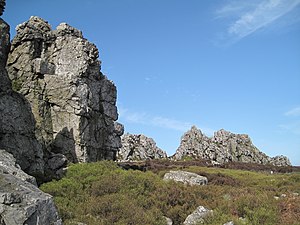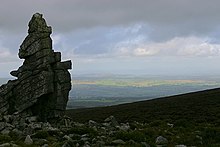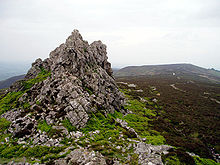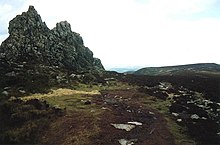Stiperstones: Difference between revisions
Created page with "{{Infobox hill |name=Stiperstones |county=Shropshire |picture=Stiperstones by bladeflyer.jpg |picture caption=On the Stiperstones |os grid ref=SO368989 |latitude=52.584358 |lo..." |
mNo edit summary |
||
| Line 2: | Line 2: | ||
|name=Stiperstones | |name=Stiperstones | ||
|county=Shropshire | |county=Shropshire | ||
|range=Shropshire Hills | |||
|picture=Stiperstones by bladeflyer.jpg | |picture=Stiperstones by bladeflyer.jpg | ||
|picture caption=On the Stiperstones | |picture caption=On the Stiperstones | ||
Latest revision as of 19:26, 23 June 2015
| Stiperstones | |||
| Shropshire | |||
|---|---|---|---|
 On the Stiperstones | |||
| Range: | Shropshire Hills | ||
| Summit: | 1,759 feet SO368989 52°35’4"N, 2°56’0"W | ||
The Stiperstones is a distinctive hill in Shropshire; a quartzite ridge formed some 480 million years ago. During the last Ice Age the summit stood out above the glaciers and was subject to constant freezing and thawing which shattered the quartzite into a mass of jumbled scree surrounding several residual rocky summit outrcrops.
At 1,759 feet above sea level, the Stiperstones is the second-highest hill in the county, surpassed only by Brown Clee Hill (1,772 feet). Stiperstones' five-mile summit ridge is crowned by several rugged, jagged outcrops of rock silhouetted against the sky.
Geography
The Stiperstones is noted for its bare summit outcrops of quartzite rock.[1] The principal tops of these are named as follows, from north-east to south-west:
| Shepherd's Rock | SO373998 |
| Devil's Chair | SO368991 |
| Manstone Rock | SO367986 |
| Cranberry Rock | SO365981 |
| Nipstone Rock | SO365969 |
| The Rock | SO351963 |
Manstone Rock is the highest of these at 1,758.5 feet (536.0 m), and is topped with a trig point. The Devil's Chair is the largest and best known.
The Stiperstones ridge is a good place to view the upland landscape of the Shropshire Hills, particularly the Long Mynd to the east, and also gives extensive views towards the North Shropshire plain and the Cambrian Mountains.
Wildlife and conservation
The Stiperstones is a National Nature Reserve and Site of Special Scientific Interest (SSSI).[2] and is within the Shropshire Hills Area of Outstanding Natural Beauty. It is a haven for wildlife, with birds that are normally associated with upland areas present, including red grouse, curlew, peregrine falcon and the rare ring ouzel.
Recently, a project called Back to Purple has commenced, to clear some of the hill of remaining plantations of coniferous and wooded areas, restoring the land to heather-based heath, with seasonal purple-flowering heather covering the summits around the tors and enhancing the views of the Stiperstones from the surrounding peaks and valleys.[3] Back to Purple is managed by a partnership of Natural England, Forest Enterprise and the Shropshire Wildlife Trust. Their work has so far seen removal of thousands of pine trees and conifers, including the whole Gatten Plantation and the previously covered Nipstone Rock has emerged from hiding. Thousands of heather seedlings have been successfully planted to supplement natural regeneration. To balance this out and complement it further work below summit level has also aimed at restoring grasslands, rich in herbs, hay meadows, wet flushes which produce bog cotton, Heath Bedstraw and the rarer Mountain Pansy and natural woodlands.
History and legend
The general area has a long history of lead mining, most notably during the Roman occupation of Britain. Several pigs of lead have been found nearby, and mining continued into Victorian times.
The area around the Stiperstones is rich in myths and folklore relating to the rocks of the Devil's Chair. According to one legend, the ghost of Wild Edric, a Saxon earl who held lands that were confiscated after 1066 and successfully defied the Normans, for a time at least, rides the hills whenever England is threatened by invasion.
The Stiperstones feature in the literary works of Mary Webb, who drew it as The Diafol (translated from Welsh, "Devil's") Mountain in her novel The Golden Arrow (1916),[4] of children's author Malcolm Saville, and in a jazz work commissioned by Music at Leasowes Bank, written and performed by the Clark Tracey Quintet. D H Lawrence used the Stiperstones and the Devil's Chair in particular as a setting for his novel St Mawr (1925).[4]
Bog Mine and Visitor Centre
The Bog, six miles north of Bishops Castle, east of the A488, (SO355979), was once a busy village with over 200 buildings. Now only a few remain.
After mining stopped, the undisturbed remnants provided a range of wildlife habitats: birds nest in the old buildings, bats roost in the old mine tunnels, and reservoirs and ponds are ideal for aquatic life.[5]
The Bog Mine Visitor Centre, the main facility for visitors to the Stiperstones, is housed in the former village school and retains its old interior design.[5] It provides historical information about the past workers, mining, and present-day work to restore the landscape. Facilities at the centre include toilets and car parking (with facilities for the disabled including reserved parking, toilets and ramps).[6] Activities include walking, with two main circular walks called Mucklewick Walk and Flenny Bank Walk and a variety of riding routes.[6]
The centre contains a framed tribute to 26 men and women from The Bog and nearby Pennerley who served the armed forces in Second World War, of whom two men died in the war and the last survivor, an airwoman, died in 2010. Headed "Lest We Forget" and bearing photographs of each named person, it was compiled and funded by local man Clifford Evans who unveiled it in the latter year.[7]
2012 fire
On 25 July 2012 part of the reserve was devastated by fire, said to have been a result of the sudden upturn in dry, hot weather coupled with the large amount of dry heather on the hills. More than 70 firemen battled the fire between 15.00 and 22.00 BST; smoke could be seen up to 10 miles away in Shrewsbury. Firefighters remained on site throughout the night because of the severity of the fire and the extent of the affected areas.[8][9]
Pictures
-
The Manstone Rocks
-
The Devil's Chair
-
The Devil's Chair
Outside links
| ("Wikimedia Commons" has material about Stiperstones) |
References
- ↑ "Stiperstones Introduction". Shropshiregeology.org.uk. http://www.shropshiregeology.org.uk/shropgeol/stiper/stipermain.html. Retrieved 26 July 2012.
- ↑ "The Stiperstones (SSSI and National Nature Reserve)". Natural England. http://www.naturalengland.org.uk/ourwork/conservation/geodiversity/englands/sites/local_ID75.aspx. Retrieved 4 September 2013.
- ↑ "Stiperstones appeal: a part of the Shropshire Wildlife Trust Site". Shropshirewildlifetrust.org.uk. 10 June 2007. Archived from the original on 10 June 2007. http://web.archive.org/web/20070610053253/http://www.shropshirewildlifetrust.org.uk/nrstiperstones.html. Retrieved 26 July 2012.
- ↑ 4.0 4.1 Dickins, Gordon (1987). An Illustrated Literary Guide to Shropshire. Shropshire Libraries. p. 116. ISBN 0-903802-37-6.
- ↑ 5.0 5.1 "Information sources". The Bog Visitor Centre. http://www.bogcentre.co.uk/. Retrieved 4 September 2013.
- ↑ 6.0 6.1 "Bog mine and visitor centre – Stiperstones". Shropshire Council. http://shropshire.gov.uk/outdoor-recreation/parks-and-countryside-sites/bog-mine-and-visitor-centre-stiperstones/. Retrieved 4 September 2013.
- ↑ Francis, Peter (2013). Shropshire War Memorials, Sites of Remembrance. YouCaxton Publications. p. 89. ISBN 978-1-909644-11-3.
- ↑ "Fire at Stiperstones nature reserve". BBC News Shropshire. 24 July 2012. http://www.bbc.co.uk/news/uk-england-shropshire-18976016. Retrieved 4 September 2013.
- ↑ "Crews put out fire at Stiperstones nature reserve". BBC News Shropshire. 25 July 2012. http://www.bbc.co.uk/news/uk-england-shropshire-18979134. Retrieved 4 September 2013.



